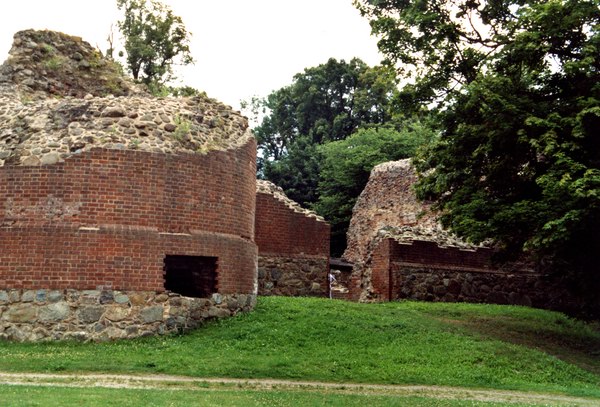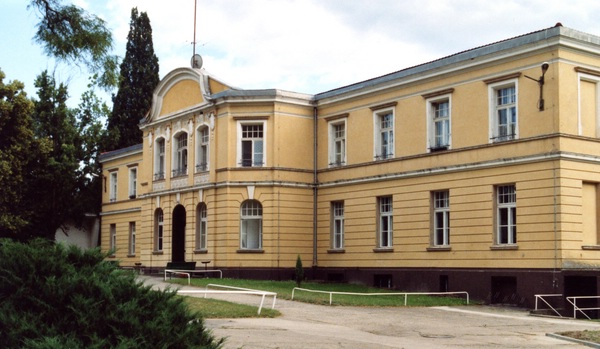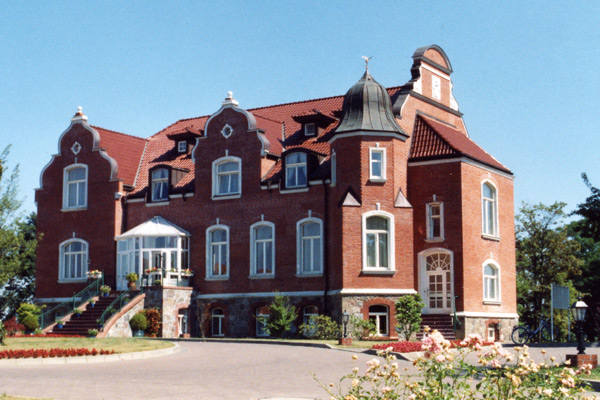The main line Gerswalde
|
Gerswalde has first been documented in 1256, and described as a border fort against Pomerania and Mecklenburg. In later years it was endowed to the Holzendorffs. In 1463, half of the estate was granted to Ludeke II von Arnim (†1470/1472), who was the margravial captain for the Ucker district. The ancestor of the Gerswalde line, Henning II von Arnim the Elder († after 1.2.1490) was granted parts of the fief, which encompassed not only the castle but also a small town with market rights. After Henning II’s death the Gerswalder estate was split between his sons, and three knightly estates evolved from that in Gerswalde in the 16th century: the ‘White House’ (Weisses Haus), which had developed from the main castle, the ‘Red House’ (Rotes Haus), which included the outer bailey (Vorburg), and the ‘Kemperhof’.
|
|
|
It was not until 200 years later that Otto XII (1682 - 1748) managed to unite all three parts in one holding again. Besides that he was able to secure ownership of other older parts of the estate that were threatened to be lost, which were the estates Fergitz and Lemmersdorf, the smaller farming estates (Vorwerk) Böckenberg, Neudorf, Kölpin, Blankensee, Werder, Petznick and Dolgen as well as the farming villages Kaakstedt, Zollchow and Jacobshagen. |
Ruins of the former castle Gerswalde |
|
Therefore, by the time of Otto’s death a sufficient number of knightly manors existed to provide his seven sons with. However, his eldest son Christof Otto (1706 - 1769) took over the management of the complete family estate Gerswalde with its chateau, small town and knightly manor, without having to buy out his brothers. |
|
|
Gerswalde 2001, the attic was not restored after being destroyed by fire. |
The Seven Years War (1756–1763) though put Christof Otto at Gerswalde into difficult circumstances: The war defeated all his plans to improve the conditions at Gerswalde. Enemy troops were prowling through his lands, whether it were Russians, Swedes or Austrians, he lost money, corn and cattle to them; the war obligations to the Prussian Army put a heavy burden on his subjects and him as well. During the last years they did not even have enough men to work the fields. |
| The farmers became bankcrupt through the amounts of corn they had to deliver to the Army, thus were not able to meet their financial obligations to the manor. The end of the war brought even more losses. The frequent transits of Prussian troops back to their headquarters again put a lot of pressure on the land and people, and the change in value of his money after the mint reform in 1764 gave a final blow to Christoph Otto’s finances. His family in the meantime had continued to grow and while the needs got bigger the family income decreased. Hence until his last day had come he couldn’t complain less about this war and its consequences (Family history, Part II., 2. Book, 1922). | |
|
Nevertheless, Christoph Otto was able to improve the estate in a number of areas, too: At the border of Gerswalder Heide he built the small farming estate Herrenstein including a dairy in 1755, and in 1764 he built a brickworks near the small Briesen lake. At this brickworks the bricks were manufactured for both a new sheep shed on the Kemperhof farm and a large cattle shed on the estate “Weisses Haus”. These two sheds being set apart from each other on two different sites should later on prove to be an obstacle for effective farming of the whole estate. |
Herrenstein 2001,
|
|
Even 15 years after the war had ended, the estate buildings were still to be found in a bad state. In 1753, Christof Otto ordered the reconstruction of the tower of Gerswalde’s parish church (origin in the 13 century) which had been destroyed by lightning five years earlier. The Arnims of the main line Gerswalde continue to live on in various branches and houses until today. You can explore the branches and houses belonging to the main line Gerswalde on the page 'Family tree'.
*1) Werner Konstantin von Arnswaldt: Das Geschlecht von Arnim, Part II., 1. Book, foreword, published by the family 1923.*2) Dr. Ernst Devrient: Das Geschlecht von Arnim, Part II., 1. Book, page 2f, published by the family 1923.
|
|


